LeafMon® Users Guide |
Introducing the LeafMon crop management tool : August 3, 2015 |
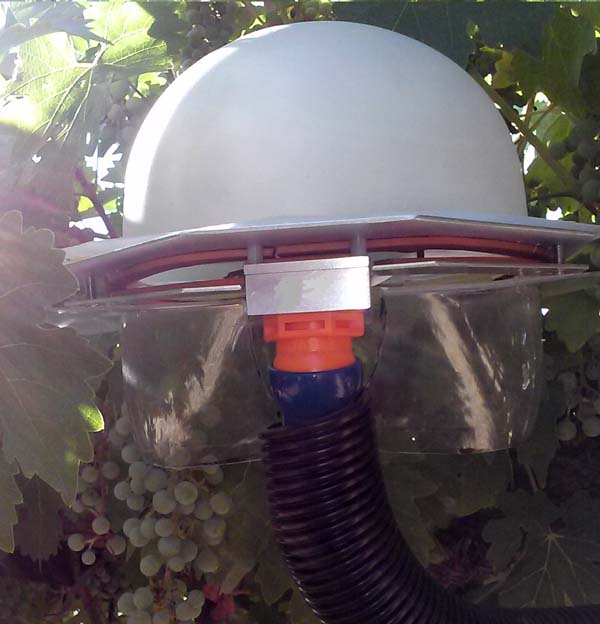
INTRODUCTION
Introducing the LeafMon crop management tool!
LeafMon measures plant transpiration performance, accounts for environmental factors influencing transpiration, and presents the results to the grower on a secure web site. LeafMon utilizes a sophisticated suite of field deployed sensors coupled with advanced Internet based software to calculate the Crop Water Stress Index (CWSI) of a tree, vine or other plant to which it is connected.
CWSI provides a normalized measure of the plant’s transpiration efficiency.
When combined with data from soil moisture sensors and Evapotranspiration data, CWSI completes the triad of a plant’s water needs assessment:
- CWSI (Crop Water Stress Index)
- ETC (Evapotranspiration)
- Available Soil Moisture
Historically, growers have had access to soil moisture and weather data.
Now, in an industry first, LeafMon makes real time plant transpiration information available. |
| |
| LeafMon Overview |
The LeafMon System determines the plant’s transpiration efficiency using multiple environmental sensors and a complex set of CWSI calculations. This sensor suite is contained in an odd looking apparatus with a bulbous head, long neck, and one metal foot. While the LeafMon may look like some robotic leach – or an escapee from a Sci-Fi movie – it is, in reality, a sophisticated scientific instrument capable of determining the level of water stress being experienced by a plant.
The bulbous head (i.e., the leaf dome) located at the top of the LeafMon unit contains multiple sensors and serves to keep a single living leaf positioned stationary for proper sensor access. This is accomplished without strain to leaf or stem and without adversely affecting leaf health allowing for continuous, accurate sensor readings throughout the entire leaf growing cycle.
The leaf dome attaches to a long flexible mounting arm which positions the leaf dome to minimize mechanical strain on the leaf positioned within the dome. On the opposite end of the mounting arm a metal bracket secures the LeafMon to a tree, vine, or other supporting structure.
The LeafMon unit is designed to remain in the field for an entire growing season. Although not necessary to the proper functioning of the LeafMon system, the LeafMon unit itself can be easily transported or repositioned to monitor a different leaf, if so desired by the grower.
LeafMon connects to a Cermetek AquaMon agricultural remote sensor and control node. The AquaMon Node provides power to the LeafMon unit, automatically retrieves sensor data, and transfers the retrieved data to a secure Cermetek web server via an embedded GPRS RF cellular link.
Cermetek’s secure web server runs a proprietary Internet based software product called Remote Sensor Viewing Platform (RSVP). RSVP is responsible for all LeafMon data management and display. It incorporates the received data into its database, calculates CWSI, and makes the CWSI values available to the grower using any browser equipped tablet, smartphone, or laptop. Display format is customizable by the grower. Internet access is password protected. |
| |
| Theory of Operation |
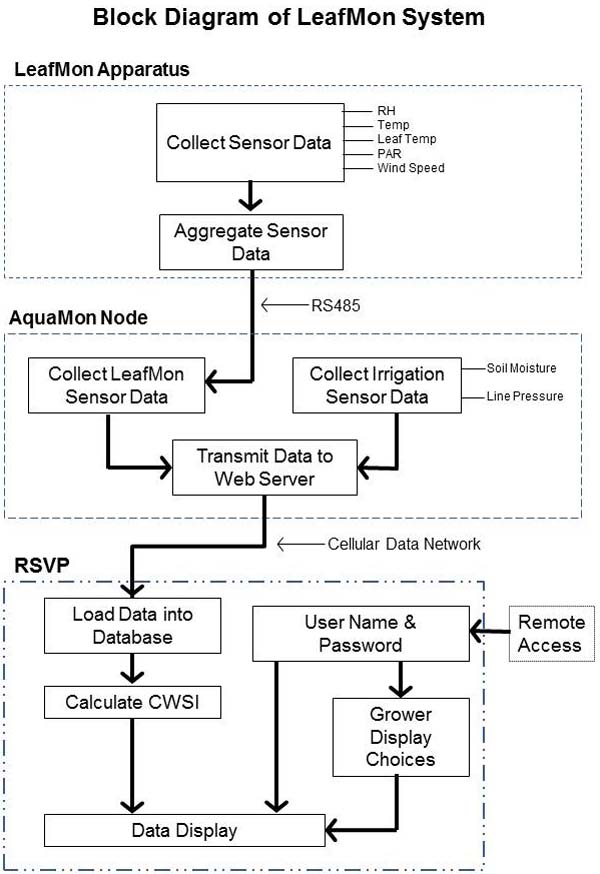
LeafMon, although deceptively easy to use, is a complex system which measures the transpiration efficiency of a tree, vine, or other plant.
LeafMon collects environmental sensor data from the field and transmits it to a web server.
Once on the web server, the RSVP software calculates the CWSI of the monitored plant using the collected sensor data.
Real time plant CWSI provides insight into the plant’s transpiration efficiency thus providing growers with a new tool to more precisely manage irrigation and water demand.
|
| |
| System Description |
The LeafMon System is, essentially, a data collection, processing and management system.
It is comprised of three distinct functional blocks:
1. LeafMon periodically collects the required leaf and environmental data utilizing a suite of sensors hidden within its translucent leaf dome..
- The on-board microcontroller aggregates the collected sensor data and caches it until data transfer is requested by the AquaMon Node.
2. AquaMon Node provides bi-directional communication and manages data transmission to/from the Internet.
- The AquaMon node also retrieves data from the LeafMon and other field deployed sensors and transfers that data via an embedded GPRS RF cellular link to a secure Internet server.
3. RSVP (Remote Sensor Viewing Platform) is Cermetek’s proprietary web based software operating on Cermetek’s secure Internet server.
- RSVP is responsible for LeafMon database management and performs CWSI calculations.
- Communication with LeafMon and non-LeafMon sensors, relays, etc., is accomplished through the RSVP platform.
- RSVP provides individual password controlled database and sensor access.
- CWSI values are available to any authorized user with a browser equipped device.
Environmental Sensor Data:
CWSI calculations require regular data collection from plant and environmental sensors.
The sensor suite resides under the LeafMon leaf dome and it measures ambient temperature, leaf temperature, solar radiation, relative humidity and wind speed.
However, one key parameter needed for accurate CWSI calculations does not originate from the leaf dome instrumentation: accurate irrigation cycle times.
The CWSI calculations need the time of the last application of water to calculate reference values.
LeafMon automatically determines the irrigation cycles by monitoring either pressure sensors inserted into the irrigation line or by monitoring soil moisture sensors inserted in the ground beneath the plant being measured.
The sensors are connected to the AquaMon Node and RSVP receives the appropriate data from the AquaMon Node.
If soil moisture or irrigation line pressure sensors cannot be employed, manual entry of irrigation cycles can be made via the RSVP software platform.
{Note: If inaccurate irrigation times are entered into RSVP, the resulting CWSI calculations may also be inaccurate.}
Data Transfer:
A microcontroller located within the leaf dome gathers the environmental sensor data. The AquaMon Node retrieves this data several times an hour from the microcontroller over a wired RS485 serial connection. The AquaMon Node then transmits the aggregated sensor data to the Cermetek secure via the embedded GPRS RF cellular link. Any data collected from soil moisture or irrigation line pressure sensors connected directly to the AquaMon Node is also sent to the Cermetek secure web server.
CWSI Calculations:
The RSVP software running on the secure Cermetek web server incorporates the incoming data from the LeafMon environmental sensors and any sensors connected to the AquaMon Node into its active database. RSVP then calculates the CWSI value and adds the CWSI value to the data base.
Data Display:
The grower has access to the CWSI values through RSVP. The grower can access RSVP using any browser equipped device including laptop, tablet or smartphone. The grower’s data, including CWSI values, are password protected. After successful logon, the grower has the option to view the available data and/or change the display parameters. |
| |
| LeafMon Mechanical Description |
The leaf dome serves two functions:
First, it holds the leaf in place so that accurate leaf temperature readings may be made.
Second, it houses a suite of electronics including various environmental sensors and a microcontroller.
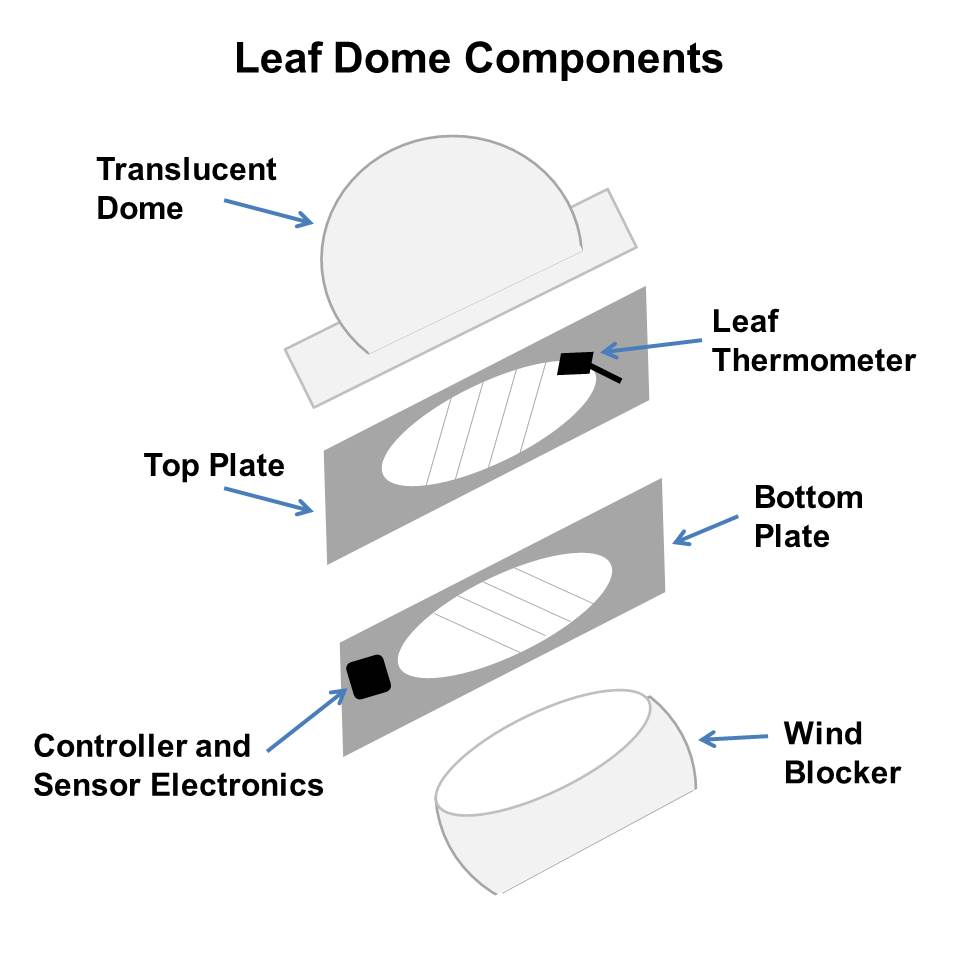
The Leaf Dome consists of five components as described below.
1. Translucent Dome:
- This component rests on the top of the leaf dome assembly.
- It diffuses any direct sunlight which might strike the sensors.
- Direct sunlight distorts sensor readings which can result in erroneous CWSI results.
- The translucent dome attaches to the top plate of the completed leaf dome assembly.
2. Top Plate:
- This is a metal plate dominated by a large circular cutout.
- A web of nylon string stretches across the cutout.
- This nylon web combines with a similar web on the bottom plate to form a net to hold the target leaf in place.
- The leaf thermometer also mounts to the top plate.
- This thermometer reads the surface temperature of the leaf which is critical for Crop Water Stress Index calculations.
- A non-contact, infrared thermometer insures that the leaf is not harmed.
3. Bottom Plate:
- The Bottom Plate is a mirror image of the Top Plate, a metal plate with a large circular cutout and nylon string webbing.
- The web on the bottom plate is offset by ninety degrees from the web on the top plate to create the net to hold the target leaf in place.
- Most of the LeafMon electronics mount to the bottom plate.
- This includes sensors for ambient temperature, relative humidity, wind speed, and photosynthetically active radiation (PAR); and the microcontroller which collects and aggregates the sensor data and supplies an RS485 communications link to the AquaMon Node.
4. Control and Sensor Electronics Module:
- Most of the LeafMon electronics are contained within the Control and Sensor Electronics Module mounted to the Bottom Plate.
- The module sensor suite includes sensors for ambient temperature, relative humidity, wind speed, and photosynthetically active radiation (PAR).
- It also contains a microcontroller which collects and aggregates data from the sensor suite and provides an RS485 communications link to the AquaMon Node.
5. Wind Blocker:
- This clear shield prevents excessive wind gusts from distorting sensor readings.
- The wind blocker resembles an upside down version of the translucent dome with the top third of the dome removed.
- This leaves the leaf and the sensors open to the elements.
- The wind blocker is made from the same translucent plastic as the leaf dome and mounts on the underside of the bottom plate.
An articulated Mounting Arm physically attaches the LeafMon to a tree, vine, or other supporting structure.
It also provides an electrical connection to the associated AquaMon Node.
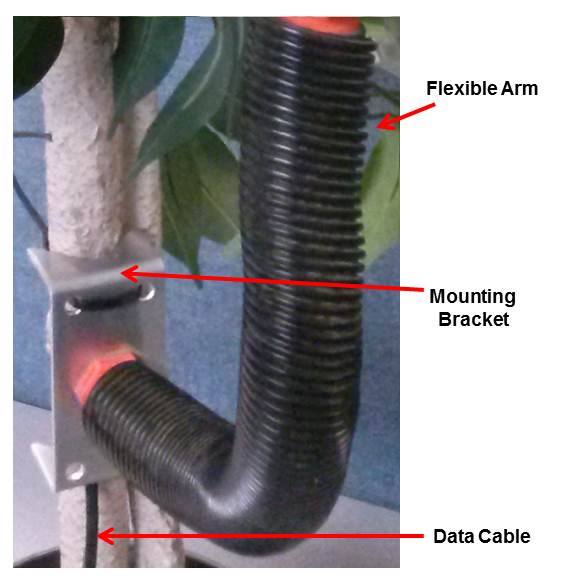 The mounting arm has three major components, as described below. The mounting arm has three major components, as described below.
1. The Flexible Arm is a hollow, articulated tube that connects the leaf dome to the plant or supporting structure.
- The Flexible Arm is a hollow, articulated tube It serves to hold the leaf dome in the desired location. Its flexibility permits adjustment of the leaf dome to insure that no strain is placed on the selected leaf or its stem.
- The hollow center of the tube provides a pathway for an RS485 data cable that connects the LeafMon electronics to the AquaMon Node.
- The standard LeafMon unit has a flexible arm that measures approximately fifteen inches. Other lengths can be ordered if needed.
- Cermetek recommends using the shortest arm possible to prevent the LeafMon from moving independently of the plant or supporting structure in high winds. Such movement could damage the leaf or its stem being held in the leaf dome.
2. The mounting bracket provides the means to affix LeafMon to the tree, vine or other supporting structure.
- For the case of trees, the LeafMon should be secured tightly to the tree to lock the movement of LeafMon to the movement of the tree.
- When the branch and the LeafMon move together it is less likely that any violent movement will impart damage to the monitored leaf.
- Cermetek provides tie wraps to secure the bracket to the tree.
- The tie wraps securely anchor the LeafMon without causing damage to the plant.
- For the case of vines or row crops, securing the LeafMon to a supporting structure, such as a pole or vine trunk, is advised.
3. The Data Cable runs inside the entire length of the mounting arm and connects the LeafMon electronics to the AquaMon Node.
- The data cable provides the RS485 data link as well as power to the LeafMon unit.
- The AquaMon Node retrieves data from the LeafMon microcontroller approximately every fifteen minutes.
- The AquaMon Node then transfers the retrieved data to a secure web server via an embedded GPRS RF cellular link for processing by RSVP.
|
| |
| LeafMon System Electrical Description |
A microcontroller and electronic sensor suite form the electrical heart of LeafMon.
The sensors generate the data used to calculate CWSI.
The microcontroller collects the sensor data and aggregates it until receiving a request from the connected AquaMon Node.
Upon receiving the request, the microcontroller transmits the buffered data over a wired RS485 data link to the AquaMon Node.
From there the data is transmitted to a secure web server via an embedded GPRS RF cellular data link.
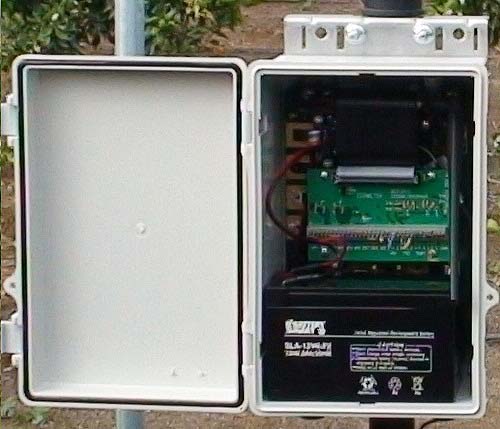
1. Electronic Sensors located within the leaf dome provide the raw environmental data for the Crop Water Stress Index calculations.
- These sensors include ambient temperature, relative humidity, wind speed and solar radiation levels.
- Sensor readings are taken several times an hour and collected by the microcontroller on board.
2. A Microcontrolleris also located within the leaf dome.
- It manages the collection of sensor data and communications with the AquaMon Node.
- Data from all sensors is collected several times an hour.
- The microcontroller aggregates the sensor readings until receiving a request for data from the AquaMon Node.
- The microcontroller then transmits the data to the AquaMon Node over a wired RS485 link.
- Once the data has been successfully sent, the microcontroller purges its data buffer and begins collecting sensor data anew..
3. The AquaMon node provides the communications link between the LeafMon and web based RSVP software; provides power to LeafMon, collects data from non-LeafMon sensors; and serves as a bidirectional controller to activate relays, pumps, etc.
- The AquaMon Node initiates the movement of sensor data from the LeafMon controller.
- Once data is received, it transmits that data to the Cermetek secure web server through an embedded GPRS RF cellular link.
- The AquaMon Node also allows additional sensors to be connected to monitor parameters such as soil moisture or pressure in irrigation lines as well as bidirectional relays to remotely activate pumps, etc.
- The data from non-LeafMon sensors is also uploaded to the Cermetek secure web server.
|
| |
| Web Software Description |
| The RSVP (Remote Sensor Viewing Platform) software running on the Cermetek web server processes the LeafMon sensor data, calculates CWSI, presents the CWSI data for on-line viewing by the grower and/or his designate, and archives the data for future use.
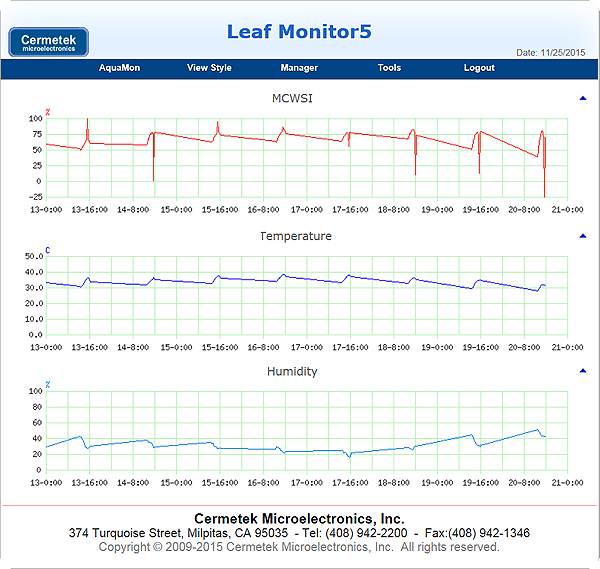 Specifically, RSVP performs the following functions: Specifically, RSVP performs the following functions:
1. RSVP integrates sensor data transmitted from the AquaMon node into its data base structure.
- Once integrated into the data base, the data can be processed or displayed by RSVP.
2. RSVP calculates CWSI from the LeafMon sensor data in the data base.
- That data includes leaf temperature ambient temperature, wind speed, humidity and solar radiation.
- The calculation also requires knowledge of the last application of water either through sensor readings or manual input.
3.RSVP provides a browser accessible platform for viewing data and controlling equipment in the field.
- Access to the RSVP web page can be achieved with any browser equipped laptop, tablet or other mobile device.
- RSVP requires password authentication before granting access to the grower data.
- RSVP also permits customization of the data display to provide the grower with a data presentation most useful to his needs.
4. RSVP archives the sensor data and the calculated CWSI.
- This allows the grower to compare current data to historical data.
- The longer the system remains in place in the field the greater the amount of available historical data.
- The grower can elect to download this archived data at any time to maintain a full history off line.
|
| |
| Installation |
Installing the LeafMon does not require any specialized tools or training but it does require attention to detail.
Care must be taken to insure that the leaf installed in the leaf dome is under no physical stress.
{Note : Minimizing leaf and stem stress is critical. Failure to do so during the installation process could inhibit leaf growth and maturation thereby adversely affecting CWSI calculations.}
Installation begins by selecting a suitable leaf, then installing that leaf into the leaf dome, and attaching the LeafMon to a tree branch or supporting structure.
The installation sequence is described below. |
Step 1: Selecting the Leaf
To achieve the most accurate Crop Water Stress Index measurements the selected leaf must meet these of guidelines.
The leaf needs to be fully mature at the time it is placed in the leaf dome.
Installing a growing leaf into the leaf dome could result in damage to the leaf and inaccurate Crop Water Stress Index results.
The leaf should also reside in a fully shaded portion of the plant.
{ Note : Failure to meet these criteria will inhibit leaf growth thereby adversely affecting CWSI calculations. } |
| Step 2: Attach LeafMon to a Branch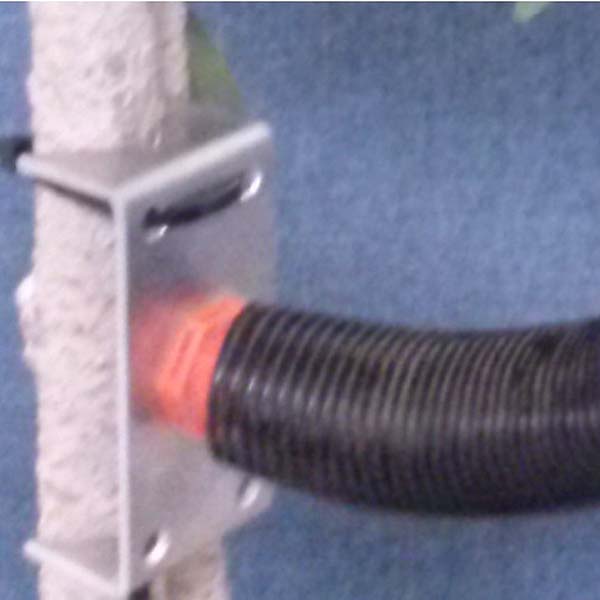
The bracket on the flexible arm ties the LeafMon assembly to the trunk or a branch of the tree.
Securely fasten the bracket to the tree using the provided tie straps.
The entire LeafMon assembly must move with the branch to which it is attached to avoid strain on the installed leaf or its stem.
Once secured to the plant, adjust the flexible arm to put the leaf dome in position to accept the selected leaf.
|
| Step 3: Install the Leaf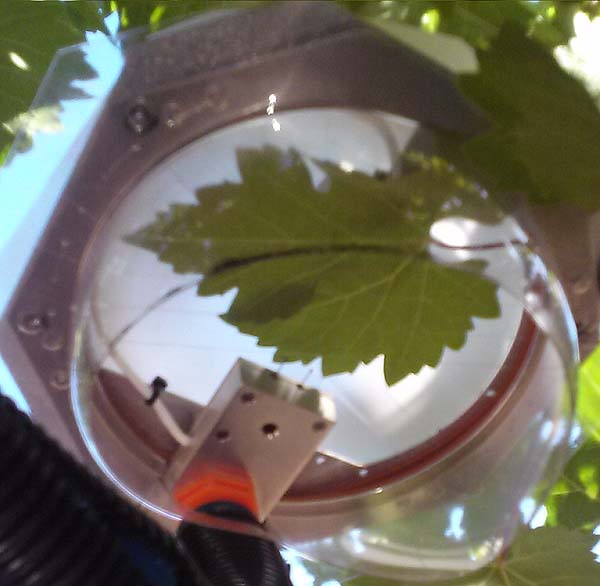
With the flexible arm in place it is time to install the selected leaf into the leaf dome.
The selected leaf must be carefully installed to avoid damage to leaf or stem.
The first step is to separate the top and bottom plates in the leaf dome; this opens the nylon mesh.
Next, set the leaf on the bottom plate and the reattach the top plate trapping the leaf in the mesh formed by the two plates.
Adjust the flexible arm as required to remove any strain on the leaf or its stem. |
Step 4: Data Cable Attachment
The data cable passes through the bendable arm and is terminated with an RS485 jack.
The RS485 jack plugs into the RS485 connector on the RS485 to RS232 adapter provided with the LeafMon.
The Adapter then plugs into the 9-pin RS232 jack in the AquaMon node.
Step 5 (OPTIONAL): Moving LeafMon
If the grower elects, or if it becomes necessary, to move the LeafMon to a different leaf - or to a new plant - during the growing season, Cermetek recommends either selecting a leaf on the same side of the tree (as the original leaf) or selecting a new plant close to original plant and selecting a leaf on the same side of the tree (as the original leaf). This way the new leaf receives approximately the same sunlight as the original leaf and consistent CWSI results can be obtained.
{ Note : When repositioning the LeafMon to a new leaf during the growing season, care must be taken to replicate as closely as possible the growing environment of the original leaf. This is necessary to maintain consistency in calculate CWSI values. }
After moving the LeafMon, new CWSI values will not be available until a new irrigation cycle begins. The new irrigation cycle permits establishment of new reference values. Attempting to calculate CWSI using reference values from the original installation will result in unreliable and inconsistent CWSI values. |
| |
| Using Crop Water Stress Index (CWSI) |
CWSI Overview:
The Crop Water Stress Index (CWSI) provides growers with an innovative irrigation decision tool that extends beyond soil moisture and ETC (evapotranspiration).
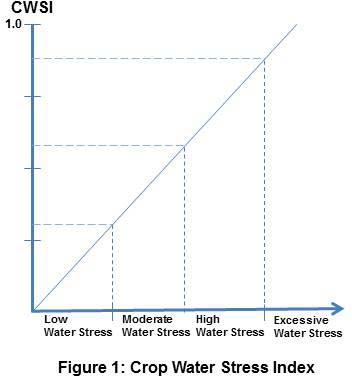 CWSI indicates actual plant performance rather than just what is happening in the environment surrounding the plant. CWSI indicates actual plant performance rather than just what is happening in the environment surrounding the plant.
In particular, CWSI allows much greater precision in the timing of irrigation events.
It allows the grower to apply water before the plant reaches a water stress state that could harm either yields and/or the long term health of the plant.
CWSI values are unit-less and range from 0.0 to 1.0.
The higher the CWSI value, the greater the level of water stress present in the plant.
The grower must establish a range of CWSI values that support good health for their specific crop.
The LeafMon system measures water stress in the plant as the water level in the soil is manipulated.
Refer to Cermetek publication 650-5322, Method For Using LeafMon to Study Water Stress Management, for a more detailed discussion of CWSI determination and for more specific information to assist the growing in establishing CWSI baselines for crops where historical CWSI values are not available.
1.Strategic Deficit Irrigation:
- There are times in the growing cycle of some crops where exposure to higher levels of water stress improves the yield or crop quality.
- An example is management of almond orchards at hull split. Reducing irrigation and thereby controllably increasing the water stress of almond trees at this phase of development, hull rot can be greatly reduced without adversely affecting the yield or causing any long term harm to the trees.
- In vineyards, growers may intentionally induce water stress to reduce fruit size to improve the end quality of the grapes..
2.Managing Soil Variations:
- Some farms have widely diverse soil types within one orchard, vineyard or field.
- Knowing the CWSI for the crops growing in these various soils allows the grower to apply water at the optimal time for each soil’s water holding capacity.
- This eliminates the need for a grower to over irrigate one section of the crop to insure that another area has sufficient water..
3.Saving Water; Protecting Yield:
- During periods of water scarcity Crop Water Stress Index allows the grower to maximize the yield for the available water supply.
- Using CWSI as his guide the grower can keep his plants operating within a selected range of stress levels preventing crop or plant damage caused by wild swings in water stress levels..
|
| |
| Managing Irrigation Using Crop Water Stress Index |
Once the installation is complete, RSVP records the sensor data provided by the LeafMon. CWSI values will begin to be displayed 24 to 48 hours after detecting the first irrigation event. CWSI provides the grower with key information concerning the condition of the plant. This information allows the grower to more precisely time subsequent applications of water.
CWSI Vs Stem Water Potential:
Many growers are familiar with Stem Water Potential (SWP) values acquired through the use of a pressure chamber or “pressure bomb.” The pressure chamber reports SWP as a pressure value in bars (where each bar is 1 equal to atmospheric pressure at sea level) or in PSI (measured in pounds per square inch). CWSI, on the other hand, is a unit less ratio ranging from 0.0 (fully saturated) to 1.0 (no transpiration). For those comfortable with the SWP numbers, research has mapped SWP vs CWSI to develop a correlation between these two sets of measurements.
The research shows that the correlation between SWP and CWSI varies from crop to crop. The two tables and accompanying comparison chart below illustrate the correlation of SWP and CWSI for Almonds and for Walnuts. As can be seen, Almonds become stressed at much higher SWP values than Walnuts. However, the stress level in Almonds rises quickly with small changes in SWP when moderate to high water stress levels are approached. Walnuts show a much more linear response to Crop Water Stress but at much lower levels of SWP. .
SWP was measured with a pressure chamber; CWSI was measured using the Cermetek’s LeafMon. Note that CWSI, as measured by LeafMon, corrects for environmental factors such as temperature and humidity - the pressure chamber does not. As a result, the CWSI varies by as much as 0.25 for a given SWP because of the influence of these various environmental factors.
The tables assume an air temperature of 90°F and a relative humidity of 30%. |
Stem Water Potential (SWP) vs Crop Water Stress Index (CWSI) in Almonds
| Stem Water Potential |
Approximate Almond CWSI |
Indicated Water Stress |
| -10 Bar |
0.02 |
Low |
| -14 Bar |
0.10 |
Mild |
| -18 Bar |
0.35 |
Moderate |
| -20 Bar |
0.50 |
Moderate to High |
| -22 Bar |
0.75 |
High |
|
Stem Water Potential (SWP) vs Crop Water Stress Index (CWSI) in Walnuts
| Stem Water Potential |
Approximate Walnut CWSI |
Indicated Water Stress |
| -10 Bar |
0.00 |
Low |
| -12 Bar |
0.10 |
Mild |
| -14 Bar |
0.25 |
Moderate |
| -10 Bar |
0.45 |
Moderate to High |
| -12 Bar |
0.65 |
High |
|
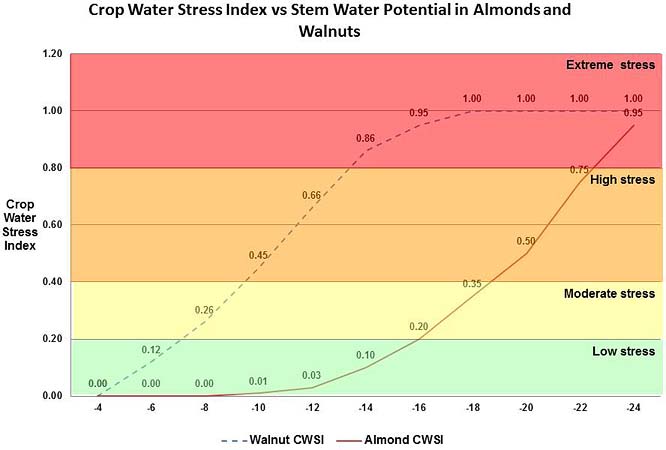 |
| |
| Building A Crop Knowledge Base |
Growers of crops without published CWSI histories can still benefit from knowing the Crop Water Stress Index for their crop by establishing a CWSI crop knowledge base. Cermetek has published a helpful guide with detailed instructions for growers to assist them in creating Crop Water Stress Index baselines for their crops and unique growing conditions of soil type, sun shading, etc. Refer to Cermetek publication 650-5322, Method For Using LeafMon to Study Water Stress Management, for a more detailed discussion of CWSI determination and for more specific information to assist the growing in establishing CWSI baselines for crops where historical CWSI values are not available.
For growers currently using pressure chambers for Stem Water Potential measurements, the grower can develop their own Stem Water Potential (SWP) versus Crop Water Stress Index (CWSI) comparisons. By comparing their pressure chamber SWP readings to the CWSI values generated by the LeafMon System, growers can quickly identify critical levels of water stress in their crop. It is recommended, that initial data be generated from a small section of crop and expanded as the grower becomes more comfortable with Cermetek’s LeafMon System and the Crop Water Stress Index values.
Growers not using pressure chambers can still benefit from the use the LeafMon system. Experiments could begin in areas with historically low yields. Compare the Crop Water Stress Index in these historically low yield sections against sections with higher yields. Comparing the Crop Water Stress Index in those two zones will indicate if the low yield plants are taking sufficient water to keep the plant from excessive water stress.
Experienced growers recognize the signs of crops under water stress. Knowing the Crop Water Stress Index when the crop exhibits signs of stress allows the grower to apply water before the water stress occurs. Growers of some crops such as olives and grapes may wish to hold their crop at a specific level of water stress to improve the quality of their fruit. Knowing the Crop Water Stress Index allows growers to maintain their crop at that desired level of stress without creating excessive stress that may do damage to the plant. |
| |
| LeafMon Models and Options |
Cermetek offers a variety of LeafMon models and options. Certain options accommodate crop variations such as leaf and plant size. Cermetek also offers growers the choice of operating the LeafMon System with AC or DC (battery/solar) power. The system can also be equipped for remote control of pumps or valves through the AquaMon Node using the RSVP software. The RSVP software itself includes options that allow the grower to adapt the system to his preferences including data display options and his choice of irrigation event triggers.
Leaf Dome Variations:
The most obvious LeafMon variation is the size of the leaf dome itself. Different plant types, with their varying leaf dimensions, necessitate the use of a leaf dome designed to accommodate the specific leaf. A leaf dome must be large enough to hold the leaf without distortion. However, if the leaf dome is too large, it becomes difficult to accurately aim the infrared leaf temperature sensor at the leaf.
Cermetek currently offers leaf domes in two sizes:
- 6.0 inch diameter dome suitable for grapes and walnuts
- 4.5 inch diameter dome suitable for almonds
- Custom dome sizes can be made to accommodate larger or smaller leaf sizes, as needed.
Length of the Flexible Arm:
The standard length of the flexible arm is approximately 15 inches. At this length, the arm reaches far enough to easily position the leaf dome and yet is short enough to securely attach to most trees or vines. However, some applications may require a shorter or longer arm length. For example, a plant with a weaker stalk or branch may need a shorter arm to reduce the mechanical stress at the mounting point. Conversely, a larger tree may require a longer arm to easily reach the target leaf.
Irrigation Cycle Trigger:
To accurately calculate the Crop Water Stress Index, RSVP calculates a new set of reference values each time the monitored plant is irrigated. To calculate these reference values, RSVP needs to identify the last application of water. Within RSVP there are three options for notification of this irrigation event.
Note: The correct sensor must be installed for the chosen irrigation trigger event.
1.Pressure Sensor:
- An inline pressure sensor incorporated into the irrigation piping circuit may be used as the irrigation trigger.
- The pressure sensor connects directly to the AquaMon Node.
- RSVP provides the grower with a pull-down menu from which to select the pressure sensor output utilized as the irrigation trigger.
2. Soil Moisture:
- RSVP also allows a fast acting soil moisture sensor to serve as the irrigation trigger.
- The soil moisture sensor must be mounted at the depth of the root ball for accurate readings.
- The soil moisture sensor connects directly to the AquaMon Node.
- A pull down menu within RSVP allows selection of the specific soil moisture sensor type serving as the irrigation trigger..
3. Manual Entry:
- If an inline pressure sensor or an in ground soil moisture sensor is NOT installed, RSVP allows the grower to manually enter the start and stop times of each irrigation cycle.
{ Note : It is critical that irrigation cycle times be entered accurately. If not, subsequent CWSI calculations will be adversely affected. } |
| |
| Power Options |
| Power to operate the LeafMon is provided by the attached AquaMon Node. The AquaMon Node can be optioned for either AC or DC (battery) operation. Battery power is the most common choice for LeafMon applications because AC power is rarely available in the field. When battery power is chosen, a solar panel maintains the battery charge throughout the growing season. |
| |
| Pump Control and Valve Control |
RSVP includes the ability to remotely activate pumps and valves. This is accomplished through the AquaMon Node. The AquaMon Node incorporates both analog and digital output lines which connect to the pump and valve control circuits to operate them remotely. Each AquaMon Node permits up to two pumps and/or valves to be activated and deactivated remotely through RSVP.
{Warning} Remote pump activation requires safeguards to be put in place at the pump site to prevent possible injury when the pump is activated. Safeguards can include a full cage around the pump to prevent direct acces to the pump, signs warning that the pump may be remotely activated at any time, and warning lights indicating that pump activation is imminent. |
| |
| LeafMon Specifications |
Below is a list of LeafMon Specifications:
- Ambient Temperature Sensor
- Range: -20° to +100°
Celsius Resolution: 0.01°
Celsius Accuracy: ±0.2° Celsius
- Leaf Temperature Sensor
- Range: -20° to +100°
Celsius Resolution: 0.01°
Celsius Accuracy: ±0.5° Celsius
- Relative Humidity
- Range: 5% to +95% noncondensing
Resolution: 0.04%
Accuracy: ±1.8%
- Photosynthetically Active Radiation (PAR)
- Range: 0 to 2400 nW/µM2
Accuracy: ± 25%
- Wind Speed
- Range 0 to 1.5 M/Sec
- Soil Moisture Sensor (Optional)
- Range: 0 to 100% Volumetric Water Content
Response Time: 10 milliseconds
Operating Temp: -40° to +50° Celsius
- Irrigation Line Pressure Sensor, Digital Output (Optional)
- Active High Pressure >3 lbs/in2
Active Low Pressure <3 lbs/in2
Operating Temp: -40° to +85° Celsius
- Warranty
- 12 months from date of shipment
Extended Warranty Optional
|
| |



 Specifically, RSVP performs the following functions:
Specifically, RSVP performs the following functions:



 The mounting arm has three major components, as described below.
The mounting arm has three major components, as described below.

 CWSI indicates actual plant performance rather than just what is happening in the environment surrounding the plant.
CWSI indicates actual plant performance rather than just what is happening in the environment surrounding the plant.